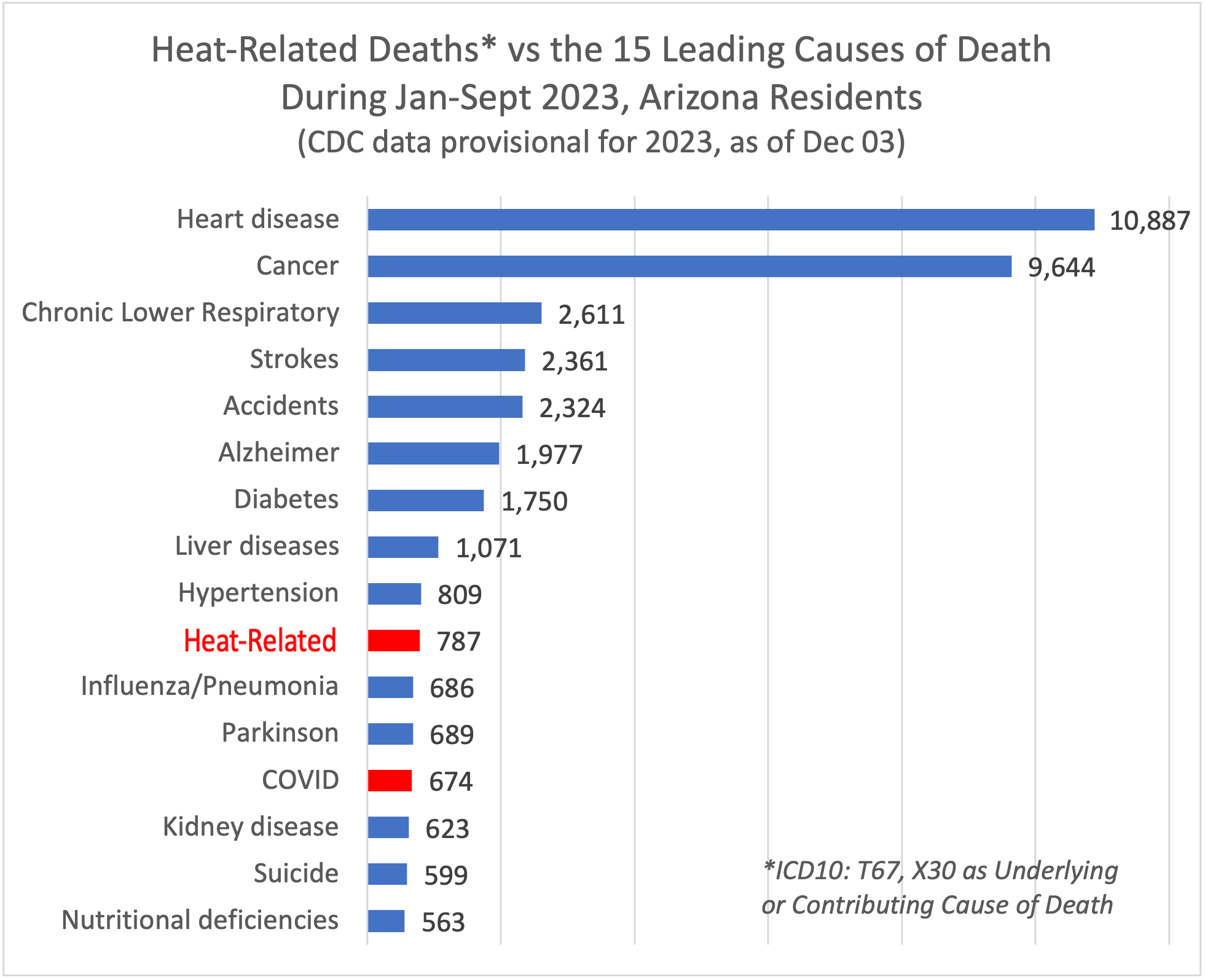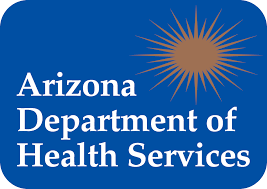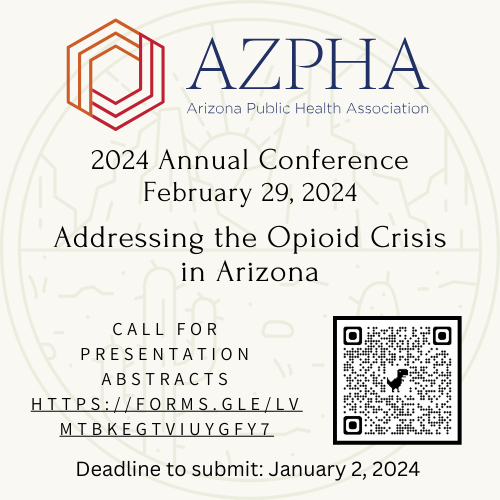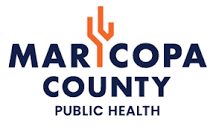Heat Deaths up 350% in Last 4 Years; COVID Drops Substantially in 2023
As you probably recall, our resident AZPHA epidemiologist Allan Willaims PhD did a deep dive into the leading causes of death in Arizona during the pandemic and discovered we were the only state where COVID-19 was the leading cause of death during the first couple years of the pandemic.
AzPHA Data Brief: Arizona is the ONLY State in the U.S. In Which COVID-19 Is the Leading Cause of Death During the Pandemic
We asked Allan to run the cause-of-death numbers again for 2023 and 2022. While COVID-19 was still the 4th leading cause of death in Arizona during 2022, it dropped way down to number 13 this year. Meanwhile, we had another dramatic jump in heat-related deaths in 2023 – moving that cause of death up to number 10 (it wasn’t even in the top 15 last year).
See: Arizona COVID-19 deaths were way down, heat-related deaths spiked in 2023 | KJZZ
An even deeper dive into the heat-related death data found that heat related deaths have increased 350% in the last 4 years (tracking the affordable housing crisis).
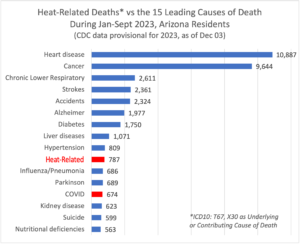
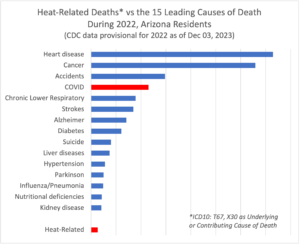
You might also notice that the Accident’s category appears to be decrease in 2023, going from #3 to #5. That shift downward is more of an artifact of timeline by which medical examiners can establish a cause of death for opioid and other poisonings (opioid and other drug overdoses are mostly classified in the Accidents category (accidental poisonings). Blood toxicology reports have a relatively long lag time, slowing the cause of death data for accidents.
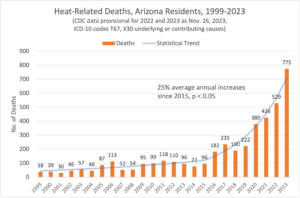
Here are some excerpts from an interview I did this week on KJZZ’ The Show: Arizona COVID-19 deaths were way down, heat-related deaths spiked in 2023 | KJZZ
Gilger: Were you surprised by any of these trends?
WILL HUMBLE: Well, I don’t know that the increase in heat-related deaths really surprised me that much. I mean, it kind of makes sense when you look at the numbers for homelessness in Arizona and the problems with affordable housing that’s putting people out into the street. Combine that with the July that we had.
We had a just a continuing big increase in heat-related deaths. And if you look at 2022, heat-related deaths wasn’t even in the top 20. This year, it’s No. 10. So, a big increase. Part of that’s homelessness. It’s a combination really of homelessness and the extreme temperatures that we had that were unusually high, especially the low temperatures at night.
Gilger: The other biggest shift when you look at these breakdowns is the big drop we saw in deaths related to COVID-19, which makes sense as well.
HUMBLE: Yeah. Right. So if you look, if you go back to 2020, 2021 Arizona was the only state where to COVID-19 was the No. 1 leading cause of death — even more than heart disease and cancer in 2020. That dropped a little bit in 2022. So that it was the fourth-leading cause of death. This year, 2023, so far it’s way down the list at No. 13. So big drop in the death from COVID-19, but a big increase in the death from heat-related illnesses.
Gilger: So much of what we talk about when we talk about deaths in the news is related to the opioid epidemic, the fentanyl crisis. How big of a chunk of the picture are those right now?
HUMBLE: It’s a big chunk. So the top two are, will always probably be — unless we have another pandemic — heart disease and cancer. But the third category is what’s called accidents. And initially you think, well, accidents mean car crashes.
Well, it’s accidental poisonings is what dominates that category, and it’s the third-leading cause of death in 2022. Right now, it’s classified as like fifth in 2023. But that’s going to go up because the toxicology reports, it takes so long to finish, they can’t establish the cause of death until that blood work comes back.
Gilger: We hear a lot about suicides in the news and about the rise in suicides, particularly among certain populations. This was lower down the list this year. How does this compare to recent years?
HUMBLE: It’s about the same as recent years in terms of the causes of death. If you look inside that data, demographically, it really is dominated by men over 70 that use a firearm as the method to end their life. So that’s demographics. If you look at where are the numbers of in suicides, it’s men over 70. Of course, there’s suicides across the board of all the age groups and genders. But that’s the, that’s the biggest chunk. It’s about the same as last year.
Gilger: Let’s talk for a few more minutes about heat-related deaths. We know that it was hotter. But we also know that there’s a housing crisis and more people are on the street and living on the street. Do we know, though, though much comorbidities play into this — things like drug use, mental illness, disability. How are those categorized?
HUMBLE: So, when you look at a death certificate, it’ll say heat-related death, there might be two to three different causes. So in other words, when you’re making the final determination … it’s about like what’s the No. 1 leading cause of death.
So, for a heat death, most likely there’s something else going on as well. Drugs is a big part, and Maricopa County did a a survey that found methamphetamine especially, but also fentanyl, are big co-factors for people who die from heat-related illnesses. But there’s the dominant reason of course is that they’re outside in the summer.
Ok… then what can we learn from these data? Public health and policy-makers can use this info to set intervention priorities etc. But individuals can learn about things they can do to improve their chances of staving off these causes of mortality.
The big factors are of course stop smoking if you smoke. Make sure to go to your annual checkup where you can learn about things like high blood pressure or early signs of diabetes & take actions to prevent bad a bad outcome. Make sure to get your routine recommended cancer screenings and stay up to date with your vaccinations.
